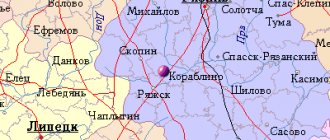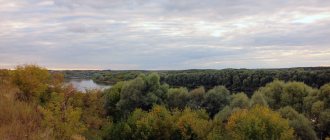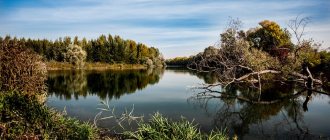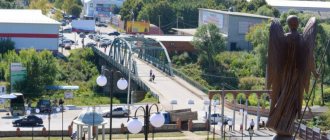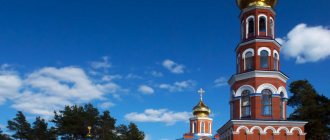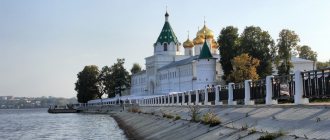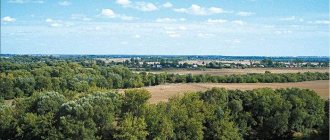| district/municipal area | |
| Ryazhsky district | |
| Flag | Coat of arms |
- (16th place)
- (2,52 %)
Ryazhsky district
- administrative-territorial unit (district) and municipal formation (municipal district) in the south of the Ryazan region.
The administrative center is the city of Ryazhsk.
Brief historical background
The city of Ryazhsk arose in the north of the long-known Ryassky field as a fortified post that controlled the portage connecting the watersheds of the Oka and Don river basins.
Small boats, plows, and canoes were dragged along the drag on wheels from the river. Khupty to the river Stanovaya Ryasa - a tributary of the river. Voronezh. They also exported furs for trade, bread, wax, and honey. In 1502, Grand Duke Ivan III, sending the Turkish ambassador to his homeland from Moscow by water, gave the order: “From old Ryazan, he should go up Proneya, and from Pronya to Pranov, and from Pranova, Khuptoy up to the portage to the Ryassky field ... and I will transport him to the Ryassky field field to the river to Ryasa...” Based on this message, historians date the first mention of Ryazhsk to 1502 and count its age from there. Experts in toponymy, in the past - D.I. Ilovaisky, modern - E.M. Murzaev, V.A. Nikonov is considered the most acceptable version of the origin of the name of the city of Ryazhsk on behalf of the Ryasa River, Ryassky Field. And in documents of the 16th and 17th centuries the name of the city appears as Ryassk, Ryaskoy, Ryaskov. In the powerful defensive system of the Moscow state of the 16th–17th centuries, the Great Zasechnaya Line, the guard stronghold fortress of Ryazhsk was of great importance, protecting Rus' from the attacks of the Crimean and Nogai Tatars. Zaseki Ryazhskaya Lipskaya, Ryazhskaya Pustotinskaya and Ryazhskaya Ranovskaya extended from the river. A couple in the east to the Skopinsky settlement in the west. These were complex systems of fortifications in which forest debris (zazaki), alternating with palisades, gouges, earthen ramparts and ditches, filled and closed the natural obstacles of the area - rivers, lakes, swamps, ravines.
The fact that Ryazhsk was a warrior city was recalled at the beginning of the 20th century. the settlements that existed around it: Streletskaya, Pushkarskaya, Yamskaya.
The ancient Ryazhsky fortress was located on a hillock, which to this day breaks off to the river. Hupte where the crimson ravine approaches it. In 1807, “the earthen fortress in the city had around 430 fathoms ... and a rampart that had all fallen off. Inside this fortress of a stone structure is a cathedral church with a bell tower, a chapel, a treasury with a storeroom. Wooden: mayor's house, public places and archive. The outskirts of this city lie on the same side as the fortress, along the Khupt River, and extend a mile and 50 fathoms in length; 2 versts wide... Crafts in this city: icon painting, tailoring, shoemaking, blacksmithing, candle making, plastering, carpentry and carpentry; There are no factories or factories...” At that time, noblemen, “officials”, merchants, townspeople, a church shelter, coachmen, full-time and retired soldiers, economic peasants, single-palace dwellers lived in Ryazhsk - a total of 3,162 people.
The population of the Ryazhskaya district participated in the first peasant war of 1606 - 1607. under the leadership of I.I. Bolotnikova. The Dutchman Isaac Massa, who lived in Moscow at that time on trade business, in “Brief news about the beginning and origin of modern wars and unrest in Muscovy that occurred before 1610,” names Ryazhsk among the cities that are “on the Tatar or Ryazan side” belonged to the rebels.
The Ryazhian lands were not spared the peasant war, the leader of which was S.T. Razin. Even after his execution, in 1675, the Razin Cossacks raised the peasants to fight near Kozlov, Ryazhsk, Tambov.
First quarter of the 18th century was marked for the Ryazhskaya district by such an event as the discovery of a coal deposit here. Near the village of Petrova, peasant Ivan Palitsyn discovered fossil coal and sent it to the Berg College. Having learned about this, Peter I in 1724 sent an expedition to Ryazhsk consisting of the “coal master” Yagon Nixon and his four assistants, specially ordered from England. In addition to foreigners in the village. Non-commissioned officer Andrei Maslov and the “miner of the government team” clerk Grigory Kapustin, who became famous at that time for his exploration of silver and iron ores and discovered coal on the Don, left Petrovo. The presence of coal deposits near Petrov was confirmed. The results of the expedition were reported to Peter I.
On October 7, 1724, he gave the Berg College a decree in which he demanded to continue the research. Peter I came up with a plan for the widespread exploitation of the open deposit for the needs of industry in the central regions of Russia and the use of rivers for the transportation of coal. Samples of the “sun stone” were delivered from the village. Petrovo to the Berg College. Thus began the development of the future Moscow Region coal basin.
Major events in the history of Ryazhsk were the participation of his regiment in the Italian and Swiss campaigns (1799) as part of Suvorov’s troops, the Patriotic War of 1812, and the war of 1877-1878, which brought liberation from the Ottoman yoke to the Bulgarian and other Slavic people. On Shipka, in the memorial complex, the names of officers and Ryazh soldiers who died in the Balkans are inscribed on marble slabs. It is impossible not to note such notable facts in the history of Ryazhsk as the establishment in 1828 of a hospital with 12 beds, the opening of a public library at the district school in 1860 using funds raised through donations.
In the 19th century, many people lived or stayed briefly in Ryazhsky district who left their mark on the destinies of Russia. To his homeland, in the village. Turovo, after serving his sentence in the fortress, the Decembrist Prince A.P. Meshchersky, a member of the Southern Society, was exiled. Another participant in the uprising of the Chernigov regiment, ensign of the 2nd musketeer company A.D. Belelyubsky, also lived in Ryazhsk.
In 1837 in the village. Egoldaevo was born I.P. Pozhalostin is the last outstanding representative of the Russian academic school of engraving. In 1868 he was awarded the title of class artist of the first degree, then academician. Having become a recognized master of reproduction engraving, I. P. Pozhalostin created works that deserved not only wide Russian, but also European fame.
In 1875-1877 at the station Ryazhsk temporarily served as senior clerk I.V. Michurin, transferred here from the station. Kozlov (now Michurinsk), later a great Russian breeder, talented experimenter, honorary member of the USSR Academy of Sciences, full member of the All-Russian Academy of Agricultural Sciences. In memory of the fact that the great biologist-breeder worked in Ryazhsk, a memorial plaque was installed on the station building, and one of the streets in the city is named after him.
In 1826-1827 In Ryazhsk, the Butyrsky Infantry Regiment, in which the Russian poet A.I. Polezhaev served, was temporarily stationed. He taught Russian at the Ryazhsky district school at the beginning of the second half of the 19th century. A. I. Levitov is the author of stories and essays about the tragic destinies of the peasant and urban poor.
The development of capitalism left its mark on Ryazhsky district. In the second half of the 19th century. Intensive construction of railways began on its territory. On the Ryazan-Kozlov section, traffic opened in 1866. A year later, trains went from Ryazhsk to Morshansk, in 1870 - to Skopin. Ryazhsk became a major railway junction at the intersection of the Ryazan-Ural and Syzran-Ryazan railways.
The stratification of the peasantry proceeded quickly. Before the Great October Socialist Revolution, about 40% of peasant households in the county were poor. The peasants, trying to ease their lot, put forward economic demands to the authorities. There were unrest in the village, which especially manifested themselves during the years of the first Russian revolution.
In December 1917, bodies of Soviet power were created in Ryazhsk. V. s. Petrovo in January 1918, the first party cell in the region arose.
On July 17, 1918, the first issue of the newspaper “Our Way” was published - the organ of the Ryazhsky district executive committee and the district committee of the RCP (b). In August 1919, the Ryazh city organization of the RKSM was created.
In 1925, the volosts were enlarged. According to the administrative division approved by the Presidium of the All-Russian Central Executive Committee on August 31, 1925, the Ryazhsky district included 8 volosts: Andreevskaya, Boretskaya, Konoplinskaya, Korablinskaya, Ryazhskaya, Sapozhkovskaya, Saraevskaya, Ukholovskaya.
By resolution of the Presidium of the All-Russian Central Executive Committee of June 19, 1926, the “List of cities in the Ryazan province” was approved. It included the city of Ryazhsk. Collectivization in the countryside took place in a very tense atmosphere. At a meeting of peasants. Bolshaya Aleshnya, at which the target figures for grain procurements were discussed, part of the wealthy peasants, as drawn up daily by the district executive committee, on September 30, 1929, created a whole row, dispersing the meeting ... ". Another report, dated November 17, 1929, says: “There were arson attacks on their farms by the fists of villagers. Tar with the words: “Burn and do not reach us or them.”
The tense situation was partly explained by excesses in the implementation of collectivization. The “Resolution of the Inter-Union Trade Union Conference of the Ryazhsky District on Correcting Distortions in Collective Farm Construction” stated that there was “a forced socialization of residential buildings, small livestock, poultry, non-marketable dairy cattle...”.
On January 14, 1929, the All-Russian Central Executive Committee of the RSFSR adopted a resolution “On the formation on the territory of the RSFSR of an administrative-territorial association of regional and regional subordination.” In development of this resolution, the All-Russian Central Executive Committee of July 12, 1929 determined the composition of districts and districts of the Moscow region and their centers. In the Moscow region, 10 districts were formed, including the Ryazan district with the center in Ryazan. The Ryazhsky district became part of the Ryazan district. This resolution also approved the list of districts and their centers by district. On the basis of the Ryazhsky district, several districts were formed: Ryazhsky, Aleksandro-Nevsky, Korablinsky, Sapozhkovsky, Saraevsky, Ukholovsky.
On July 23, 1930, a resolution was adopted by the Central Executive Committee and the Council of People's Commissars of the RSFSR “On the liquidation of districts,” according to which the final deadline for the liquidation of districts was October 1, 1930. The resolution indicated that there would be no changes to the boundaries of districts and village councils. All districts of the Moscow region, including Ryazan, were liquidated.
By the resolution of the Central Executive Committee of the USSR of September 26, 1937 on the division of the Moscow region into Tula, Ryazan and Moscow, the Ryazan region was formed. Ryazhsky district became part of it.
During the Great Patriotic War, everything in the region was subordinated to the interests of the defense of the Motherland. Already on June 25, 1941, the Ryazhsky region was under martial law. At the end of November, Nazi units came close to the city of Ryazhsk and the city and its suburbs, by order of the garrison, went into a state of siege. A militia detachment numbering 3 thousand people was created. A fighter battalion from the militia, armed with rifles and Molotov cocktails, took up defense near the Shuvalovsky forestry, and on the Ryazhsk-Skopin road. Fascist aircraft bombed Ryazhsky station, Art. Sheremetyevo, railway station near the village. Poplevino. At this time, a train with the 3rd battalion of the 84th Marine Brigade arrived in Ryazhsk. By order of General S.N. Rudenko, who was later a Hero of the Soviet Union, an air marshal, who was in Ryazhsk, the battalion was sent to the city of Skopin and on the same day knocked out the Nazis from the city.
For active participation in the fight against the Nazi invaders, several thousand residents of Ryazhsk and the region were awarded orders and medals. In this glorious line there are also Heroes of the Soviet Union. Among them are A. G. Zhuravlev, S. I. Kolesnikov, P. M. Konyaev, S. N. Kostrov, I. M. Krasikov, S. N. Laputin, A. V. Larin, M. I. Nikanorov, G. V. Pavlov, S. I. Politov, N. P. Seleznev, A. M. Serebryakov. At the brotherly cemetery of Ryazhsk there is an obelisk in honor of the fallen soldiers, on it are the words: “To you, who gave the flame of life for the sake of life on Earth.” Monuments and obelisks commemorating those killed in the Great Patriotic War were erected in the villages of the region.
By the Decree of the Presidium of the Supreme Soviet of the RSFSR dated April 5, 1956, 9 districts were liquidated in the region, including Zheltukhinsky, its territory became part of the Ryazhsky district.
On the basis of the Decree of the Presidium of the Supreme Council of the RSFSR “On strengthening rural areas, forming industrial districts and changing the subordination of districts and cities of the Ryazan region,” 12 rural and industrial districts were formed in the region. The Ryazhsky rural district was formed.
In January 1965, on the basis of the Decree of the Presidium of the Supreme Council of the RSFSR dated January 12, 1965 “On changes in the administrative and territorial division of the Ryazan region,” rural and industrial areas were liquidated. Ryazhsky rural district was transformed into a district. The city of Ryazhsk was included in the Ryazhsky district.
Famous natives[edit | edit code]
See also: Category:Born in the Ryazhsky district
- Anisimova, Domna Anisimovna (1812-1868), daughter of a sexton. Blind (“Blind Domanya”), poetess.
- Bobrovnikov, Nikolai Ivanovich - Soviet economist and statesman.
- Bolshakov, Kirill Andreevich (1906), Soviet inorganic chemist, corresponding member of the USSR Academy of Sciences (1958). Rector of the Moscow Institute of Fine Chemical Technology named after. M. V. Lomonosov, twice laureate of the USSR State Prize.
- Vekovishchev, Vasily Vasilievich (1923-1988), teacher, local historian
- Dubrovin, Yuri Dmitrievich (1939), actor of the Kyiv Film Studio named after A. Dovzhenko, one of the most filmed Ukrainian actors, Honored Artist of the Russian Federation, honorary citizen of Ryazhsk.
- Zhukov, Viktor Petrovich (1923-1984), Hero of Socialist Labor, chairman of the Lenin's Path collective farm, Ryazhsky district.
- Zhuravlev, Alexander Grigorievich (1910-2010), senior lieutenant of the Soviet Army, participant in the Great Patriotic War, Hero of the Soviet Union (1943). He was buried at the Fraternal Cemetery in Ryazhsk.
- Ignatiev, Pyotr Vasilievich (1925-1981), full holder of the Order of Glory.
- Klyuev, Viktor Vladimirovich (1925), Hero of Socialist Labor, Moscow smelter.
- Kolesnikov, Semyon Nikitovich (1911-1975), guard senior lieutenant, commander of a rifle company of the 3rd motorized rifle battalion of the 7th Guards Motorized Brigade, Hero of the Soviet Union.
- Konyaev, Pyotr Mikhailovich (1922-1951), senior lieutenant, flight commander of the 482nd Kovno Order of Alexander Nevsky Fighter Aviation Regiment, Hero of the Soviet Union.
- Kotlyarenko, Anatoly Nikolaevich (1903 - after 1966), linguist, literary critic, candidate of philological sciences, associate professor.
- Krasikov, Nikolai Maksimovich (1924-1944), guard lieutenant, tank commander of the 48th Guards Separate Tank Regiment, Hero of the Soviet Union. One of the streets in Ryazhsk is named after him.
- Laputin, Sergei Yakovlevich (1911-1985), tank platoon commander, Hero of the Soviet Union. (1938 - for the Spanish Civil War). There is a street in Ryazhsk with his name.
- Larin, Andrey Vasilyevich (1911-1981), sergeant, squad commander of the 981st Infantry Regiment, Hero of the Soviet Union.
- Lebedev, Vasily Ivanovich (1825-1863), theologian, church leader, editor of the magazine “Soulful Reading”.
- Leontyev, Boris Mikhailovich (1924), Doctor of Law, Professor of the Law Faculty of Moscow State University.
- Likhachev, Vladimir Matveevich (1901-1975), Soviet military leader, colonel general of artillery.
- Lunin, Nikolai Aleksandrovich (1915-1968) - innovator of railway transport, Hero of Socialist Labor, laureate of the USSR State Prize.
- Makarov, Ivan Ivanovich (writer). In prose he refers to the first years of socialist construction.
- Meshchersky, Alexander Petrovich, prince (about 1804 -?), Decembrist - member of the Southern Society, ensign of the Chernigov infantry regiment. Participant in the uprising of the Chernigov regiment, but soon after it began he fled and reported to his superiors. According to the conclusion of the Audit Department, he was sentenced to imprisonment for 6 months in a fortress, followed by assignment to service. After serving his sentence, he was returned to the same regiment, dismissed from service in 1828, and lived in the village of Turovo.
- Muravyov, Anatoly Vasilievich (1924-1993), scientist-historian, professor at Moscow State University.
- Nazin, Ivan Zakharovich (1910-1982), Major General of Aviation.
- Nefedov, Fedor Mikhailovich (1888-1929), poet. The first publication was in the children's magazine “Guiding Light” (1916). In the post-October years, he was published in the magazines “Murzilka”, “Rabotnitsa”, “Rails”, “Harvest”, and in central newspapers. In the last years of his life, he headed school No. 80 in the Krasnopresnensky district of Moscow.
- Novikov, Anatoly Vladimirovich (1924), Doctor of Technical Sciences, Professor.
- Novikov, Boris Kuzmich (1925-1997), Soviet theater and film actor, People's Artist of Russia (1994).
- Okaemov, Alexander Ivanovich (1905-1943), soloist of the Moscow Philharmonic, associate professor at the Moscow Conservatory, member of an underground group in the Mogilev region (Belarus) during the Great Patriotic War. There is a memorial stele installed near the house where he lived. The street bears his name.
- Onisifor (Ponomarev) (in the world - Pyotr Alekseevich Ponomarev; 1881-1966), Archbishop of Kaluga and Borovsk.
- Pirumova, Natalya Mikhailovna (Iosifovna) (1923-1997), scientist-historian, Doctor of Historical Sciences.
- Pozhalostin, Ivan Petrovich (1837-1909), artist-engraver. One of the last masters of copper engraving in Russian art. He spent the last years of his life in Solotch. He was buried on the territory of the Spassky Monastery of the Ryazan Kremlin. Streets in Ryazhsk and Ryazan are named in honor of I.P. Pozhalostin.
- Politov, Semyon Ivanovich (1913-1980), commander of the 1st division of the 876th Red Banner Howitzer Artillery Regiment, Hero of the Soviet Union. One of the streets of Ryazhsk bears his name.
- Rybnikov, Alexander Alexandrovich (1878-1938), Soviet economist and economic geographer, author of works on agricultural production and the theory of economic geography.
- Ryazanov, Viktor Timofeevich (1949), Doctor of Economics, full member of the Russian Academy of Natural Sciences, Honored Worker of Higher Education of the Russian Federation
- Serebryakov, Andrei Mikhailovich (1913-1942), junior lieutenant, commander of a tank company named after Felix Dzerzhinsky, Hero of the Soviet Union. A street in Ryazhsk is named after him.
- Sokolov, Ivan Timofeevich (1900-1950), physicist, candidate of technical sciences, laureate of the USSR State Prize.
- Struchkov, Viktor Ivanovich (1907-1988), surgeon, academician of the USSR Academy of Medical Sciences, laureate of the Lenin and State Prizes of the USSR, Hero of Socialist Labor. Honorary citizen of Ryazhsk. In Ryazhsk there is a street with his name.
- Tambovsky, Anatoly Nikolaevich (1955), Doctor of Pedagogical Sciences, Professor of the Russian State Russian State Technical University, Master of Sports in bullet shooting, Russian record holder (1982)
- Tatanov, Ivan Vasilievich (1935), General Director of MUP Vodokanal (Ryazan), Doctor of Technical Sciences, Corresponding Member of the Housing and Communal Academy. Honorary citizen of Ryazan.
- Utkina, Fedosya Semyonovna (1908-1992), the first Ryazan woman tractor driver.
Status
Municipal entity - Ryazhsky municipal district is an independent municipal entity within the Ryazan region.
It was established within modern borders on November 3, 1965 by Decree of the Presidium of the Supreme Soviet of the RSFSR.
In accordance with Law No. 92-OZ of October 7, 2004, the boundaries of the Ryazhsky municipal district and the boundaries of the municipalities included in its composition were established.
The charter of the municipal formation - Ryazhsky municipal district was adopted by the decision of the district Duma of October 24, 1996 and registered on January 30, 1997 No. 23. The new version of the charter was adopted by the Decision of the Ryazhsky District Duma No. 375 of March 31, 2011.
Notes[edit | edit code]
- ↑ 1234567
Ryazan Oblast. Total land area of the municipality - ↑ 123456789
The permanent population of the Russian Federation by municipalities as of January 1, 2021 (Russian). Date accessed: April 27, 2021. Archived May 2, 2021. - Handbook on the administrative-territorial division of the Moscow region 1929-2004. - M.: Kuchkovo pole, 2011. - 896 p. — 1500 copies. — ISBN 978-5-9950-0105-8.
- All-Union Population Census of 1939. The current population of the USSR by regions and cities (unspecified)
. Retrieved November 20, 2013. Archived November 16, 2013. - All-Union Population Census of 1959. The actual population of cities and other settlements, districts, regional centers and large rural settlements as of January 15, 1959 by republics, territories and regions of the RSFSR (unspecified)
. Retrieved October 10, 2013. Archived October 10, 2013. - All-Union population census of 1970. The actual population of cities, urban-type settlements, districts and regional centers of the USSR according to census data as of January 15, 1970 by republic, territory and region (unspecified)
. Retrieved October 14, 2013. Archived October 14, 2013. - All-Union Population Census of 1979. The current population of the RSFSR, autonomous republics, autonomous regions and districts, territories, regions, districts, urban settlements, village-district centers and rural settlements with a population of over 5,000 people (unspecified)
. - All-Union population census of 1989. Population of the USSR, RSFSR and its territorial units by gender (undefined)
. Archived from the original on August 23, 2011. - All-Russian population census 2002. Volume. 1, table 4. Population of Russia, federal districts, constituent entities of the Russian Federation, districts, urban settlements, rural settlements - regional centers and rural settlements with a population of 3 thousand or more (unspecified)
. Archived from the original on February 3, 2012. - The size of the permanent population of the Russian Federation by cities, urban-type settlements and regions as of January 1, 2009 (unspecified)
. Retrieved January 2, 2014. Archived January 2, 2014. - All-Russian population census 2010. 11. Population of the Ryazan region, urban districts, municipal districts, urban and rural settlements (unspecified)
. Access date: December 10, 2013. Archived December 10, 2013. - Population of the Russian Federation by municipalities. Table 35. Estimated resident population as of January 1, 2012 (unspecified)
. Retrieved May 31, 2014. Archived May 31, 2014. - Population of the Russian Federation by municipalities as of January 1, 2013. - M.: Federal State Statistics Service Rosstat, 2013. - 528 p. (Table 33. Population of urban districts, municipal districts, urban and rural settlements, urban settlements, rural settlements) (undefined)
. Retrieved November 16, 2013. Archived November 16, 2013. - Table 33. Population of the Russian Federation by municipalities as of January 1, 2014 (unspecified)
. Access date: August 2, 2014. Archived August 2, 2014. - Population of the Russian Federation by municipalities as of January 1, 2015 (unspecified)
. Access date: August 6, 2015. Archived August 6, 2015. - Population of the Russian Federation by municipalities as of January 1, 2021 (Russian) (October 5, 2018). Date accessed: May 15, 2021. Archived May 8, 2021.
- Population of the Russian Federation by municipalities as of January 1, 2021 (Russian) (July 31, 2017). Retrieved July 31, 2021. Archived July 31, 2021.
- Population of the Russian Federation by municipalities as of January 1, 2021 (Russian). Retrieved July 25, 2018. Archived July 26, 2021.
- Population of the Russian Federation by municipalities as of January 1, 2021 (Russian). Date accessed: July 31, 2019. Archived May 2, 2021.
- Population of the Russian Federation by municipalities as of January 1, 2021 (Russian). Date accessed: October 17, 2021. Archived October 17, 2021.
- Law of the Ryazan Region of September 12, 2007 N 128-oz “On the administrative-territorial structure of the Ryazan Region”
- ↑ 12
Register of administrative-territorial units and settlements of the Ryazan region (Resolution of the Government of the Ryazan region dated April 20, 2021 N 7) - ↑ 12
Law of the Ryazan Region of October 7, 2004 N 92-OZ “On granting the municipal formation - Ryazhsky District the status of a municipal district, on establishing its boundaries and the boundaries of the municipalities included in its composition” - ↑ 1 2 3 4 5 6 7 8 9 10 11 12 13 14 15 16 17 18 19 20 21 22 23 24 25 26 27 28 29 30 31 32 33 34 35 36 37 38 39 40 41 42 43 44 45 46 47 48 49 50 51 52 53 54 55 56 57 58 59 60
All-Russian population census 2010.
5. Population of rural settlements in the Ryazan region (unspecified)
. Access date: December 10, 2013. Archived December 10, 2013.
History of the coat of arms
The coat of arms of the municipal formation - the Ryazhsky municipal district was approved at a meeting of the Ryazhsky District Duma by decision No. 161 of 08.25.97 and registered in the State Heraldry, registration No. 283 of 10.06. '98.
Description of the coat of arms: in a silver field there is an azure (blue, blue) left wavy band, on which, on top of its upper edge, is placed, at an angle forward, a golden ryazh (log house), filled with silver stones; in the golden free part with a rounded corner there is an old green princely hat with a black sable edge, above which there is a gold decoration (“town”) with a pearl.
The flag of the municipal formation - Ryazhsky municipal district was approved at a meeting of the Ryazhsky District Duma by decision dated April 13, 2002, No. 12.
Description of the flag: the flag is a rectangular panel with a width to length ratio of 2:3, longitudinally divided into 3 equal horizontal stripes: golden yellow, azure and white. In the center of the middle azure stripe there is an image of a golden-yellow rhombus in a belt, having a height equal to the width of the stripe and a ratio of its own height to width of 4:5.
The procedure for the official use of the symbols of the municipal formation - Ryazhsky municipal district is approved by the district Duma.
Geographical position
The municipal entity Ryazhsky municipal district is located in the south of the Ryazan region. Its area is 101,858 hectares, the length of the territory from north to south is 30 km, from west to east – 33 km.
The administrative center of the district is the city of Ryazhsk. Located at a distance of 113 km from the regional center of Ryazan.
From the east, the municipality borders on the Ukholovsky district, from the south - on the Novoderevensky district and the Lipetsk region, from the west - on the Miloslavsky and Skopinsky districts, and from the north - on the Korablinsky district.
The length of the territory from north to south is 30 km, from west to east – 33 km. The territory of the municipality consists of all lands of urban and rural settlements.
The area covers an area of 101,858 hectares, including:
| land category | area, ha | square, % |
| agricultural land | 80 993 | 79,5 |
| incl. land redistribution fund | 312 | 0,3 |
| lands of settlements | 7818 | 7,7 |
| lands of industry, energy, transport, communications, radio broadcasting, television, computer science, lands for space activities, lands of defense, security and lands of other special purposes | 2386 | 2,3 |
| forest fund lands | 8328 | 8,2 |
| water fund lands | 419 | 0,4 |
| reserve lands | 1914 | 1,9 |
| Total | 101858 | 100 |
Administrative division
The territory of the municipal district includes the territories of municipalities:
1. the territory of the Ryazhsky urban settlement;
2. territories of rural settlements:
— Aleshinskoye rural settlement (administrative center of the village of Bolshaya Aleshnya). The Aleshinskoye rural settlement of the Ryazhsky municipal district includes the following settlements: the villages of Bolshaya Aleshnya, Bolshoye Samarino, Vvedenovka, Gremyachka, Marchuki 1, Ratmanovo, Turovo, Sheremetyevo, the villages of Alekseevka, Borshchevoe, Kiselevka, Malaya Aleshnya, Maryino, Mikhailovka, Pogorelovka, Sovka, Teleshovka, the villages of Zorka, Kolesnitsky, Komintern, Marchukovskie Vyselki, Svet, Utro, Sheremetyevo stations.
— Degtyanskoye rural settlement (administrative center is the village of Degtyanoye). The Degtyanskoye rural settlement of the Ryazhsky municipal district includes the following settlements: the villages of Degtyanoye, Vasilevka, Novoye Egoldaevo, the village of Staroye Egoldaevo, the village of Yegoldaevo station.
— Zhuravinskoe rural settlement (administrative center is the village of Zhuravinka). The Zhuravinskoye rural settlement of the Ryazhsky municipal district includes the following settlements: the villages of Zhuravinka, Berezovo, Aleksandrovka, Zezyulino, Kurovshchino, Lykovo, Marchuki 2, Naberezhnoe, Nagornoye, Polotebnoye, Saltyki, Khmelevoye, the villages of Volkovo, Esakovo, Kuzminka, the villages of Krasny Oktyabr, Lesnichestvo Shuvalova, New World.
— Petrovskoye rural settlement (administrative center is the village of Petrovo). The Petrovskoye rural settlement of the Ryazhsky municipal district includes the following settlements: the village of Petrovo, the village of Dmitrievka, the village of Solntse.
— Poplevinskoe rural settlement (administrative center is the village of Poplevino). The Poplevinskoye rural settlement of the Ryazhsky municipal district includes the following settlements: the villages of Poplevino, Podvislovo, Chirkovo, the villages of Kuchukovo, Maloe Samarino, Osinovka, Chernava, the villages of Dobraya Volya, Lupilovka, Podvislovo stations.
Territorial structure[edit | edit code]
Main article: Administrative-territorial division of the Ryazhsky district
As part of the administrative-territorial structure, the Ryazhsky district includes 1 city of regional significance and 5 rural districts[21][22].
As part of the organization of local self-government, the municipal district is divided into 6 municipalities, including 1 urban and 5 rural settlements[23].
| № | Municipality | Administrative center | Number of settlements | Population (persons) | Area (km²) |
| 1 | Ryazhskoe urban settlement | Ryazhsk city | 1 | ↘20 641[2] | 126,13[1] |
| 2 | Aleshinskoye rural settlement | village of Bolshaya Aleshnya | 24 | ↘2005[2] | 304,40[1] |
| 3 | Degtyanskoye rural settlement | Degtyanoye village | 5 | ↗1400[2] | 133,80[1] |
| 4 | Zhuravinskoye rural settlement | Zhuravinka village | 18 | ↘1343[2] | 210,00[1] |
| 5 | Petrovskoye rural settlement | Petrovo village | 3 | ↘1064[2] | 71,30[1] |
| 6 | Poplevinskoye rural settlement | Poplevino village | 10 | ↘1254[2] | 172,95[1] |
Climate, minerals, water resources, soils, forests
The climate of the area is temperate continental, with moderately warm summers and moderately cold winters. Precipitation is distributed unevenly throughout the year.
Mineral resources - peat, crushed stone, clay, sand, coal.
Water resources are determined by the Ranova and Khupta rivers with their tributaries, as well as lakes Konchurovskoye and Chernoe (in the oxbow of the Ranova River). There are five large ponds: Grachi, Egoldaevskoye, Tribuna facility, Samarino, Ryazhsky.
The soils of the region are gray forest (47%), 53% are chernozems of varying degrees of erosion and leaching. Soils need liming, phosphorite treatment, and the application of complex mineral and organic fertilizers.
Forests occupy up to 10% of the district's territory in the northern, northeastern parts of the district and in the floodplain of the river. Ranova. There is Ryazhskoe forestry.
Industry
The number of industrial enterprises in 2012 was 4 units.
The largest enterprises in the region:
• OJSC “Ryazhsky Automobile Repair Plant”
Address: 391962, Ryazan region, Ryazhsky district, Ryazhsk, st. Novo-Ryazhskaya, 86.
Tel.: (849132) 3-02-30.
Fax: (849132) 2-02-30.
Year of creation: 1957.
The company produces machines for housing and communal services.
• OJSC “Ryazhskaya Printing Factory”
Address: 391964, Ryazan region, Ryazhsky district, Ryazhsk, st. Engelsa, no. 124.
Tel.:(849132) 43-9-60
Fax: (849132) 43-9-60
The company produces marked and unmarked envelopes.
• Ryazhsky Cellar LLC
Address: 391962, Ryazan region, Ryazhsky district, Ryazhsk, st. Svobody, no. 62.
Tel.: (849132) 21-0-98
Fax: (849132) 21-9-42
Year of creation: 2002
The company produces canned vegetables.
• Ryazhsky Dairy Plant LLC
Address: 391962, Ryazan region, Ryazhsky district, Ryazhsk, Sovetskaya st., 14
Tel.: (849132) 21-0-88
Fax: (849132) 21-0-88
The company produces whole milk products.
Tourist resources
Cultural and educational tourism
Ryazhsky Museum of Local Lore
The museum is located in an ancient building - the former home of the merchant Petrov.
The museum has stationary exhibitions “History of the Ryazhsk region from ancient times”, “Ryazhsk is a county town. End of the 19th century - beginning of the 20th century,” three exhibition halls, a literary salon, and a scientific library. The pride of the museum is the collection of the memorial fund - materials about fellow countrymen who glorified their land and Fatherland. Documents, personal belongings, and awards are presented here. The museum initiated the development of the tourist route “Bow to the Great Sons of Russia”, dedicated to the memory of the heroes of Russia A.S. Kaisarova, P.A. Kikina, M.D. Skobeleva. Address: Ryazan region, Ryazhsk, st. Komsomolskaya, 11/41 Tel.: (49132) 2-18-66, 4-36-40 Manor of the Kikins-Ermolovs
(XIX century) Manor in the village.
Bolshaya Aleshnya is the former patrimony of the ancient Kikin family, who took an active part, together with the Ryazan governor Prokopiy Lyapunov, in ridding Moscow of False Dmitry. Among the many owners of the estate is the hero of the war of 1812, Pyotr Andreevich Kikin. Having become the owner of Bolshaya Aleshna, he laid out a large park here, which was worthy of description in the geography of Russia by P.P. Semenov-Tyan-Shansky. The Church of the Virgin Mary has been preserved from the beginning of the 19th century. The Bolshaya Aleshni estate was rebuilt in the second half of the 19th century under A.S. Ermolov, president of the Free Economic Society, who turned his estate into a highly cultural, economically profitable agricultural enterprise. He also founded a stud farm here. Estate of General Smelsky
(XIX century) Manor house in the village. Vasilevka is a two-story mansion, an architectural monument of the 2nd half of the 19th century. The monument complex includes buildings: a manor house, a kitchen, a stable and a cellar. The facades of the building are very picturesque and richly decorated. All buildings of the estate are distinguished by the high quality of construction work. The owners of the estate are representatives of the family of hereditary military Smelskys. Address: Ryazan region, Ryazhsk, st. Komsomolskaya, 11/41 Tel.: (49132) 2-18-66, 4-36-40
"Ryazhsky Zoo"
Opening hours: 10.00 – 17.00
The zoo is FREE.
OPEN ON WEEKENDS AND HOLIDAYS!
Address: Ryazan region, Ryazhsky district, Svet village.
Tel.: +79009018828
Agriculture
The leading industries in agriculture are the production of grain, milk, meat, and sugar beets. Grain production in the total volume of production in 2012 occupies - 15.1%, milk - 14.0%, meat - 66.7%, sugar beets - 4.2%.
Plant growing. The land fund of the Ryazhsky municipal district is 101,858 hectares, of which 80,993 hectares are agricultural land.
Cereals. The cereal crops grown in the area are corn, wheat, barley, and oats.
Industrial crops. Potatoes and sugar beets are grown among industrial crops in the region.
Transport
The area is provided with 3 intercity bus routes (Ryazan, Ukholovo, Alexander Nevsky), 6 city routes and 9 suburban routes. In addition, company buses are used to transport their workers, while other citizens also use the transport services.
The city of Ryazhsk is a large railway junction in four directions - to Ryazan, Voronezh, Tula, Penza.
Ryazhsk is the center of the intersection of the Ryazan-Tambov, Ryazan-Volgograd and Ryazan Ring highways.
Population[edit | edit code]
| Population | ||||||||
| 1939[4] | 1959[5] | 1970[6] | 1979[7] | 1989[8] | 2002[9] | 2009[10] | 2010[11] | 2012[12] |
| 57 496 | ↘47 466 | ↘44 054 | ↘39 050 | ↘37 322 | ↘31 097 | ↘29 352 | ↘29 026 | ↗29 281 |
| 2013[13] | 2014[14] | 2015[15] | 2016[16] | 2017[17] | 2018[18] | 2019[19] | 2020[20] | 2021[2] |
| ↗29 429 | ↘29 395 | ↘29 343 | ↗29 399 | ↘29 302 | ↘28 892 | ↘28 421 | ↘28 116 | ↘27 707 |
Urbanization
The urban population (city of Ryazhsk) makes up 74.5% of the region's population.
Culture, education, social life
In the region there is a municipal cultural institution “Ryazhskaya Central Library”, which includes 18 libraries: central, children’s, 3 city and 13 rural libraries. The Ryazhskaya Children's Music School has a piano, folk and choir department, and the number of teachers is 16 people. MBOU DOD "Ryazhskaya Children's Art School", number of teachers 6 people. The municipal cultural institution “Ryazhsky District House of Culture” includes: the district House of Culture, 16 rural Houses of Culture.
The municipal cultural institution “Ryazhsky Museum of Local Lore” is a cultural, educational and scientific research institution, custodian of historical and cultural monuments.
Municipal educational institutions are represented by: including: 16 preschool educational institutions, 4 secondary schools (9 branches), 3 additional educational institutions for children and adolescents.
Almost all periods of development of the Ryazhsky district left their mark on architectural buildings.
The building of the former men's gymnasium, built at the beginning of the 19th century, now houses secondary school No. 1. Hero of the Soviet Union S.I. Politov, theater and film artist B.E. Lebedev, writer I.I. Makarov, singer A.I. Okaemov studied there.
The buildings of the shopping arcade, built in the second half of the 19th century, have now been restored and are used as shops.
Church of the Nativity of Ryazhskaya old-timers is better known as the Church of the Nativity of the Virgin. The history of the temple dates back to the 17th century. According to the scribe book of 1685, his parish included “... in the settlement and in the village of Khulotka (now the village of Vvedenovka) sixteen households of Ryazan and Ryazhan landowners, fifty-seven dragoon and Cossack households, thirty-one peasant households, ten Bobyl households, and a total of 111 yards."
A stone church with chapels in honor of the Nativity of the Blessed Virgin Mary began to be built in 1822. In 1883, her parish consisted of 277 households.
Reconstruction of the church began in 2009, and the first service took place in 2011.
